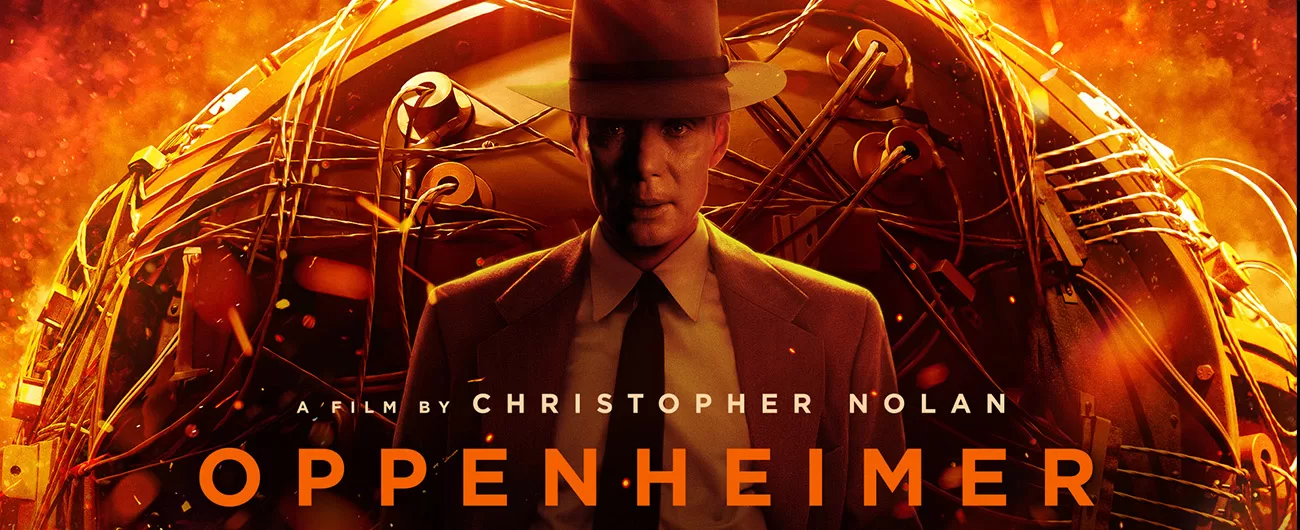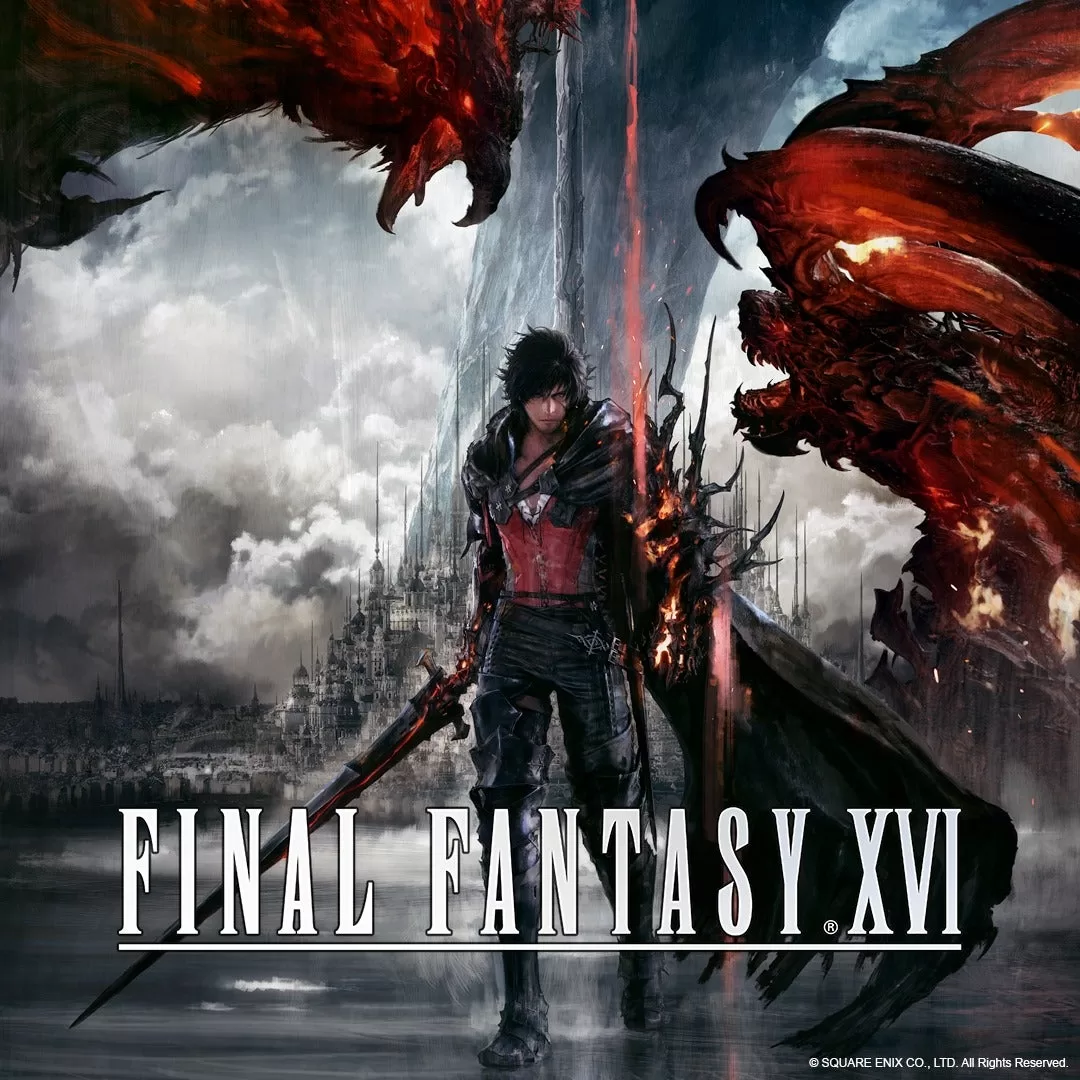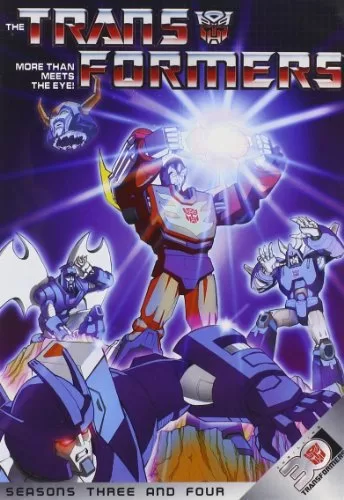
“A Red-Headed Red Herring“: A Retrospective of Claremont’s X-Men, Part 11
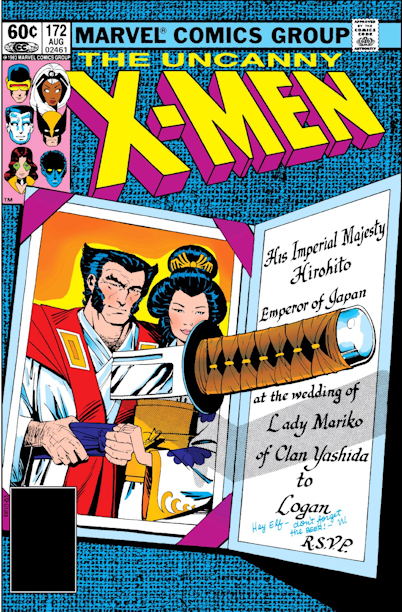
As the X-Men line truly began to expand for the first time, Chris Claremont had begun perhaps his greatest creative period since the John Byrne era. In our last installment of this Retrospective, we discussed two of his all-time greatest stories—God Loves, Man Kills and the Wolverine limited series, both of which have gone on to become iconic X-Men tales. New Mutants had yet to hit its creative heights, but it was growing in its creative consistency, allowing Claremont to tell more experimental stories about students in mutant boarding school. At the same time, Uncanny X-Men reached its own new heights after the conclusion of the Brood Saga.
The Brood Saga was perhaps not the best first outing for Paul Smith, who had not yet had the material to show his true greatness as an artist. That story was very clearly written for Dave Cockrum, who had previously drawn the book before Smith’s arrival. The best parts of that story were drawn by Cockrum, and Smith had broken in on what proved to be a challenging story to draw. Claremont’s best stories were often written to the strengths of his artists, and Paul Smith’s strengths had yet to truly be put on display. That would change in the issues following the Brood Saga, beginning with the appropriately titled “Professor Xavier is a Jerk!”.
In previous episodes of the Retrospective, we’ve discussed some of the failings of Charles Xavier, and how he’s not always written as the patron saint of mutantkind as he’s often portrayed. We’ve seen, for instance, that he had no moral qualms about getting into a romantic relationship with a patient he was treating for severe psychological trauma, a woman that he would father a son by. (Xavier’s son is revealed to be David Haller, known otherwise as Legion, who Claremont introduces in New Mutants.) We’ve also seen in God Loves, Man Kills that Xavier harbors deep guilt for his many sins, both real and imagined. In deference to Claremont on this issue, he was quite possibly the best writer of Xavier in the comics, as later portrayals were often even less favorable to him. I would assert that the best writers ever to write Charles Xavier are, in fact, the writers of X-Men: The Animated Series, who kept him human without portraying the deep moral lapses that we’ve seen in the comics.
Because of Xavier’s history of questionable morality, the title of this issue has become a widespread meme among X-Men fans. Paul Smith’s opening splash page featuring the issue’s title is memorable and iconic today. Some of this is because the page is so beautifully laid out and captures the expressiveness of Kitty Pryde as she thunders out the iconic line. However, the other reason this page constantly comes back, why it is so well remembered, is because Kitty so effectively sums up the feelings of many X-Men fans towards the founder of the team. Charles Xavier has often been written as a jerk, both under Claremont and under other writers, both before and after Claremont. Some of this goes back to Xavier’s Silver Age portrayal, whether it was harboring romantic feelings towards a teenaged Jean Grey (a fact that was brought up prior to the Onslaught event years later) or lying to his students for manipulative purposes (such as faking his death twice). Later stories have cast doubt on his character as well, especially retcons like Deadly Genesis or even his actions as leader of Krakoa’s Quiet Council during Jonathan Hickman’s run. The pronouncement that Professor Xavier is a “jerk”, then, resonates strongly among X-Men fandom, and for good reason.
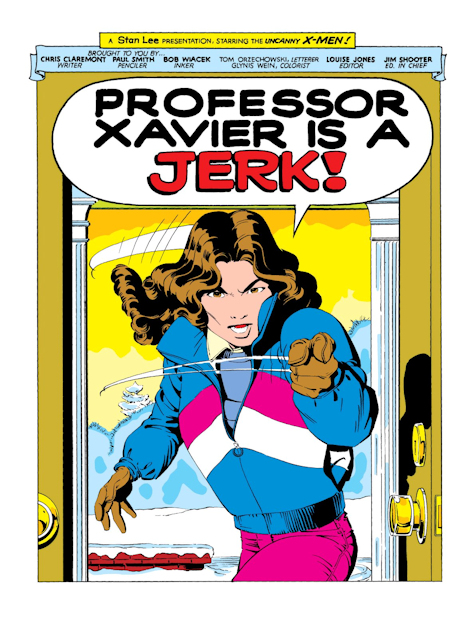
In fairness to Xavier, in the case of the actual story, Xavier arguably does have a valid point of view. As mentioned in previous episodes, the idea of two teams of mutants living under the same roof was new at the time. At this point of time, Xavier had established clear roles for the two teams—the X-Men were the superheroes, while the New Mutants existed only to be a team of junior trainees. Kitty Pryde was the same age as the New Mutants, still a young girl in school herself, and she’d already been in danger several times by this point. By this time, she came within inches of dying at the hands of a N’Garai demon, Magneto had very nearly killed her on his island, and she’d also been nearly killed by the Brood just before her return to Earth with the X-Men. It is quite understandable why Xavier would not want to risk her life any further, especially given his guilt over his role in the deaths of John Proudstar and Jean Grey. Although his ruling to demote Kitty to the New Mutants sounds harsh, even coming across as a punishment in her eyes, Xavier likely was acting in what he believed was her best interests. We don’t truly know his full reasons as Xavier never explains them. Very likely, Xavier feared allowing another student to die on his watch, especially after losing Karma only recently to Viper and the Silver Samurai over in New Mutants. Although driven in part by his own guilt, the desire to keep Kitty safe is only a natural one, especially for someone like Xavier who has a duty of care to his students.
The story very much sympathizes with Kitty’s position, though it’s not clear if it’s because she’s one of Claremont’s favorites or because we’re seeing this story through her eyes. Still, Claremont does present both sides as having valid positions, and we see this especially when Nightcrawler and Wolverine debate the issue. Logan perhaps presents the best argument for keeping Kitty in the X-Men, reminding Kurt that children younger than Kitty were sailors during wartime and they still managed to distinguish themselves in battle. Although Kitty is not a soldier, we have seen her clear intelligence and problem-solving ability save the X-Men time and again in past adventures. To Logan, Kitty has earned the right to be an X-Man because of her record, because she’s proven herself to him where it counts.
The question that is never raised in this is whether Kitty lost her childhood because of her decision to be an X-Man, a decision she made before she’d fully matured on an emotional level. That is a difficult question to address, and it’s arguable that she has, especially given how much she suffers because of her decision to join the team. She had already by this time nearly been killed more than once, and she would later have her mind invaded by a demon ninja, an inner battle that would nearly destroy her. One could easily make the case that Xavier is making a wise decision here by protecting Kitty from a dangerous world she may not be ready for, despite her brilliance and her experience with the X-Men. To the extent Xavier can be faulted here, it’s primarily that he’s cold and brusque in his handling of Kitty, and he never discusses his full reasons with anyone.
We will never know the answer to this question, because Kitty wastes no time in proving her case to Xavier that she should be reinstated to the X-Men. We see her try every weapon in her arsenal to persuade him to change his mind, though he refuses in each case. At times, It works on a comedic level, as Kitty is willing to go to any lengths to return to the team. Both sides are convinced that they’re right, and the issue is very much a battle of wills between Xavier in his headstrong young student.
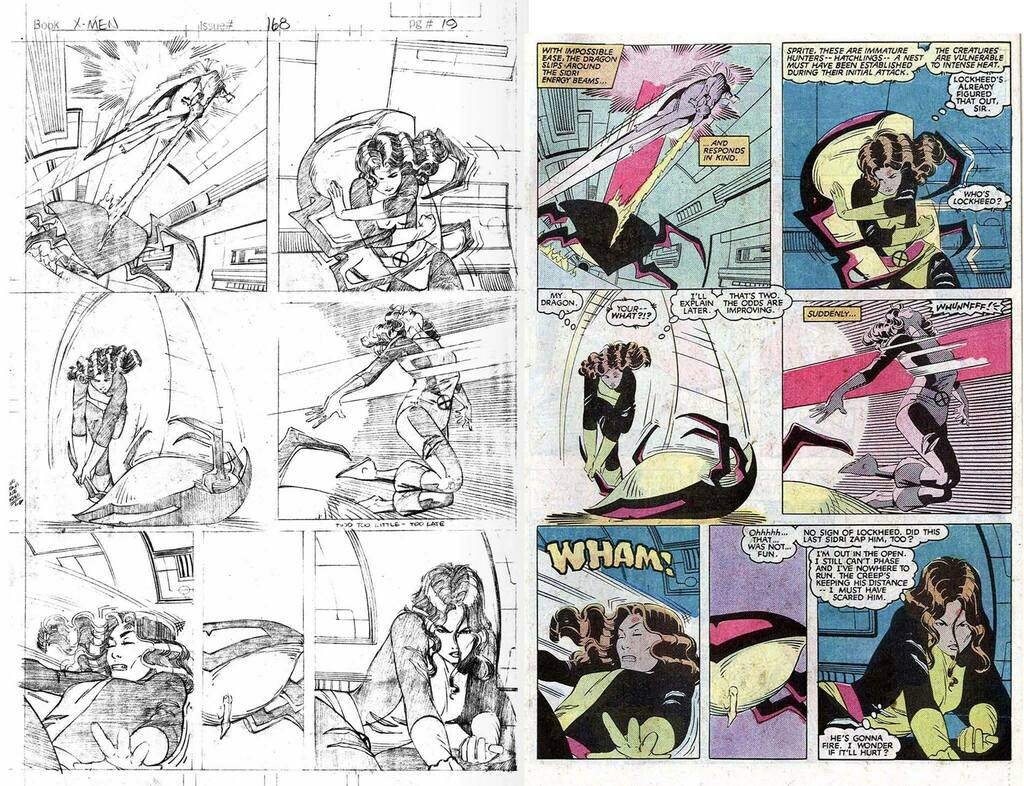
However, the two are not alone, as Lockheed the dragon has stowed away and followed the X-Men back to the mansion after the Brood Saga. It isn’t clear how exactly Lockheed managed to hide from the X-Men and the Starjammers, or how he managed to follow them to the mansion. Claremont handwaves these points away, establishing only that Lockheed managed to follow them back and still lives in hiding in the mansion. As the narration points out, Lockheed has been unable to find food suitable for a young dragon, and the hunting hasn’t gone well for him. He’s determined to change this, spying on the X-Men as they go through their daily lives.
The situation changes when Kitty is forced to investigate the basement levels of the mansion because of a power loss. The cause, as it turns out, is a chewed power line, though Kitty isn’t yet certain what is at cause. At first, this appears to be Lockheed, who she finds in one of the dark alcoves beneath the mansion. The true answer turns out to be more dangerous—the remnants of the Sidri, who had made a nest in the mansion’s catacombs. With help from Colossus, Kitty and Lockheed defeat the Sidri, and this convinces Xavier to reconsider her case. Xavier decides that she’s more capable than he’d first believed, and he allows Lockheed to stay and Kitty to return to the X-Men, but only on the condition that she maintains her grade. An ecstatic Kitty agrees to these terms, and she and Xavier are reconciled from then on.
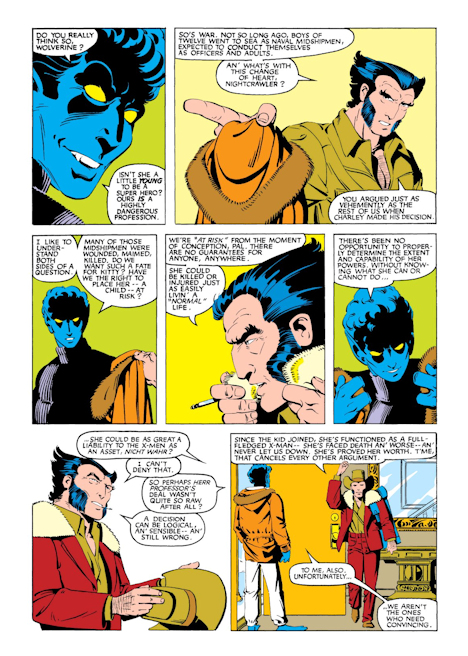
“Professor Xavier is a Jerk!” ranks as one of my personal favorite Kitty stories, as it clearly shows why Kitty Pryde belongs with the X-Men. It raises some reasonable questions about what makes someone worthy to be an X-Man. Kitty proves her worth to Xavier and to the team, and we see what separates her from the New Mutants. In the end, it’s her drive and her experiences that make her an X-Man, and her lack of life experience and emotional maturity are not a barrier to that. She is a young woman who even at that age was capable of making adult decisions in combat, proving Logan right about his estimation of her. This story was her trial by fire, and it proves in no uncertain terms where she belongs—with her friends and their cause.
Towards the end of the issue, the focus turns to the Summers family—Scott, Alex, and Corsair—as they go to Alaska to meet Scott’s grandparents. Along the way, Claremont introduces a character who proves to have major impact on Cyclops, for better and for worse. This character is perhaps one of the most misunderstood characters in the X-Men mythos, mainly due to the history of retcons surrounding this character. For a time, she is an excellent supporting character and love interest, and she remains perhaps my favorite non-powered X-Men supporting character during this period. Unfortunately, for reasons we’ll get into in more depth in later columns, she strays very far from that conception and becomes a different character entirely. Her name is Madelyne Pryor.
Today, most X-Men fans know Madelyne Pryor as a villain and a clone of Jean Grey, and this is regrettable. That was not Claremont’s original idea for her or his original plan for the character. The reason for the modern view of Maddie mainly stems from the retcons and revelations of the Inferno crossover (which we will discuss more thoroughly in a later column), and her characterization from that point onwards. Maddie Pryor’s past and characterization were vastly changed from Claremont’s original conception. This was done in response to later events, mainly corporate-driven ones, that we will cover in future Retrospective columns, such as the resurrection of Jean Grey.
Madelyne Pryor also is a character who has been badly mistreated over the years. As Claremont himself would later admit, she was “screwed” in his view. This is due to no fault of the character, because during her earlier portrayals, she is an outstanding supporting character with some good moments. She is especially a strong character during the Paul Smith era on Uncanny X-Men, where she was written according to Claremont’s original concept. Maddie is at her best towards the end of this period during the Mastermind arc, in fact. Unfortunately, because of corporate influence in later years and unintended consequences stemming from Jean’s return, Maddie becomes increasingly marginalized and vilified over the years until she becomes the villain we know her as today. Maddie was never a villain by creative design, but a victim of circumstance who descended into villainy. Claremont was involved in some of these decisions, especially towards Inferno, but he was largely reacting to a situation that he didn’t create and couldn’t control.
Going into the Mastermind arc and her relationship with Cyclops, it’s important to understand that Madelyne was never meant to be a clone at all. She was always meant to be a normal human woman who just happened to look like Jean Grey; the resemblance was meant to be purely a coincidence. Chris Claremont created Madelyne because he was inspired by Alfred Hitchcock’s classic film Vertigo. In that film, the James Stewart character (coincidentally nicknamed “Scottie”) becomes obsessed with a woman he’s investigating played by Kim Novak (also named “Madeleine”). In the first half of the film, Scottie falls in love with Madeleine, and he later watches her die. After the death and Madeleine’s inquest, the Scottie character discovers another woman who is a dead ringer for the woman he loved and lost; we eventually learn that she is Madeleine’s body double, a woman named Judy Barton. Wanting to do his own “Vertigo” story, the name “Madelyne Pryor” was chosen deliberately by Claremont. “Madelyne” is a direct nod to the Kim Novak character in Vertigo (with a small spelling change), and Pryor referred to Maddie’s “prior” existence as Jean Grey.
Many years later, as part of Sequart’s documentary titled Chris Claremont’s X-Men, Claremont would discuss Maddie’s origins. He revealed his original plans in depth in an interview done as part of the documentary, alongside writer/editors Louise Simonson and Ann Nocenti, who were also involved in the storyline. In the words of Claremont, Maddie was intended to be a “redhead red herring” and nothing more:
Madelyne Pryor was never intended to be a villain by Claremont or his editors, nor was she ever meant to be a clone of Jean Grey. She was always meant to be a body double of Jean Grey, a woman who happened to look like her, in a deliberate homage to Hitchcock. They always intended to tease the reader with the possibility that she might be Jean Grey or someone connected to her, but it was always a tease. The real story was about using the Madelyne character to confront Scott with his own baggage associated with Jean’s death. The idea was for Scott to move on from Jean’s memory, begin a life with Madelyne, and start a new chapter of his life. Unfortunately, because of the nature of corporate comics, Scott and Madelyne would never get that closure. Because of this, Maddie was twisted into a completely different and much darker character from the one that Claremont envisioned her as.
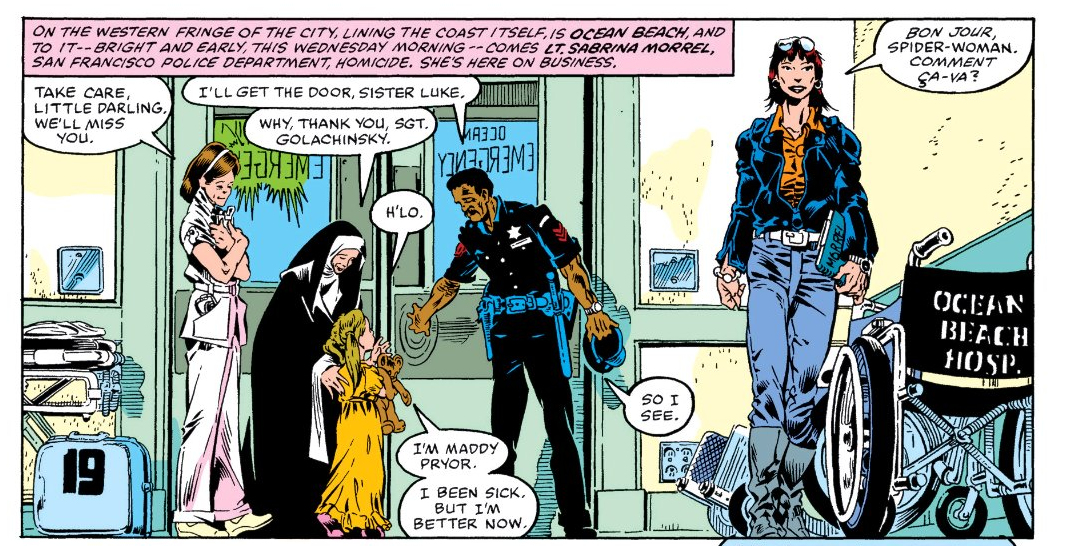
The Alaska scene is technically is not the first time we meet Maddie, at least if you go by the Inferno version of events. In Avengers Annual #10 (discussed in a previous Retrospective), Claremont brings in a young girl named “Maddy Pryor” as part of the hospital scene with Spider-Woman early in the issue. This was also a tease and wasn’t meant to be anything more than what is shown. However, this scene is relevant because it shows how long the name was on Claremont’s mind, and it is also a scene that proves to be directly relevant in the Inferno retcon of Maddie’s origins. In the end, though, this was not originally intended to be the same character as the Madelyne Pryor that we see during the Smith run.
The cover for the next issue shows the return of the Angel, who has been. The cover depicts Angel in captivity for unrevealed reasons, with his wings spread behind him. Later in the issue, we learn that he has been kidnapped from his home by Callisto, the ruler of the Morlocks, who wants to make Angel her consort. The issue opens as Angel’s then-girlfriend, Candy Southern, returns home and stumbles on the scene of the kidnapping. She finds Angel’s missing feathers that were removed during the struggle, and then upon something even worse. She finds the Morlock Sunder, a super-strong mutant, who threatens her. It’s a very effective cold open for the issue, and though we don’t yet know who the Morlocks are, they come across as a convincing threat. Xavier psychically alerts Nightcrawler, who is the closest to the scene, and Kurt manages to rescue Candy after Sunder throws her through a high-story window. The X-Men, driven to rescue one of their own, head into the Morlock tunnels to save their friend and former teammate. It’s a perfectly workable story setup, and the mystery of the Morlocks is compelling enough to keep interest.
However, the imagery presented with the Angel, both on the cover and in a key interior page, is striking and one of the most visually interesting parts of the Morlocks’ introduction story. Claremont deals with the image of crucifixion a few times, most notably with God Loves, Man Kills and then with Wolverine much later, during the Marc Silvestri run on the book. With Angel, though, the Christian imagery fits the character in a macabre way, though here he is treated as an object of desire rather than a martyr for a cause. Because of this motivation, it seems more likely that Claremont (possibly with involvement from Smith) intended this scene as an homage to the French comic Barbarella and the 1968 movie adaptation starring Jane Fonda and John Phillip Law. In the film version, Law plays an angel named Pygar, who also becomes the prisoner of unwanted love by the Black Queen, much as Callisto does with the Angel. Claremont is no stranger to sexually fetishistic elements in his comics, as we’ve seen previously with the Hellfire Club (which Claremont gave a Black Queen of its own). Claremont likely also was familiar with Barbarella—the angelic imagery is evocative of the film, but he may also have known the comics as well, given his British upbringing. During this period, Claremont draws heavily on influence from classic film, and it resulted in some powerful storytelling. At the same time, he made these elements fit the Claremont style, as they were all recognizable while looking like Claremont stories. If there is a downside to the use of Angel here, it’s that he has no agency or even any speaking lines, as he’s unconscious through the entire story. Still, it is a very fascinating parallel and a good reference to a classic cult film.
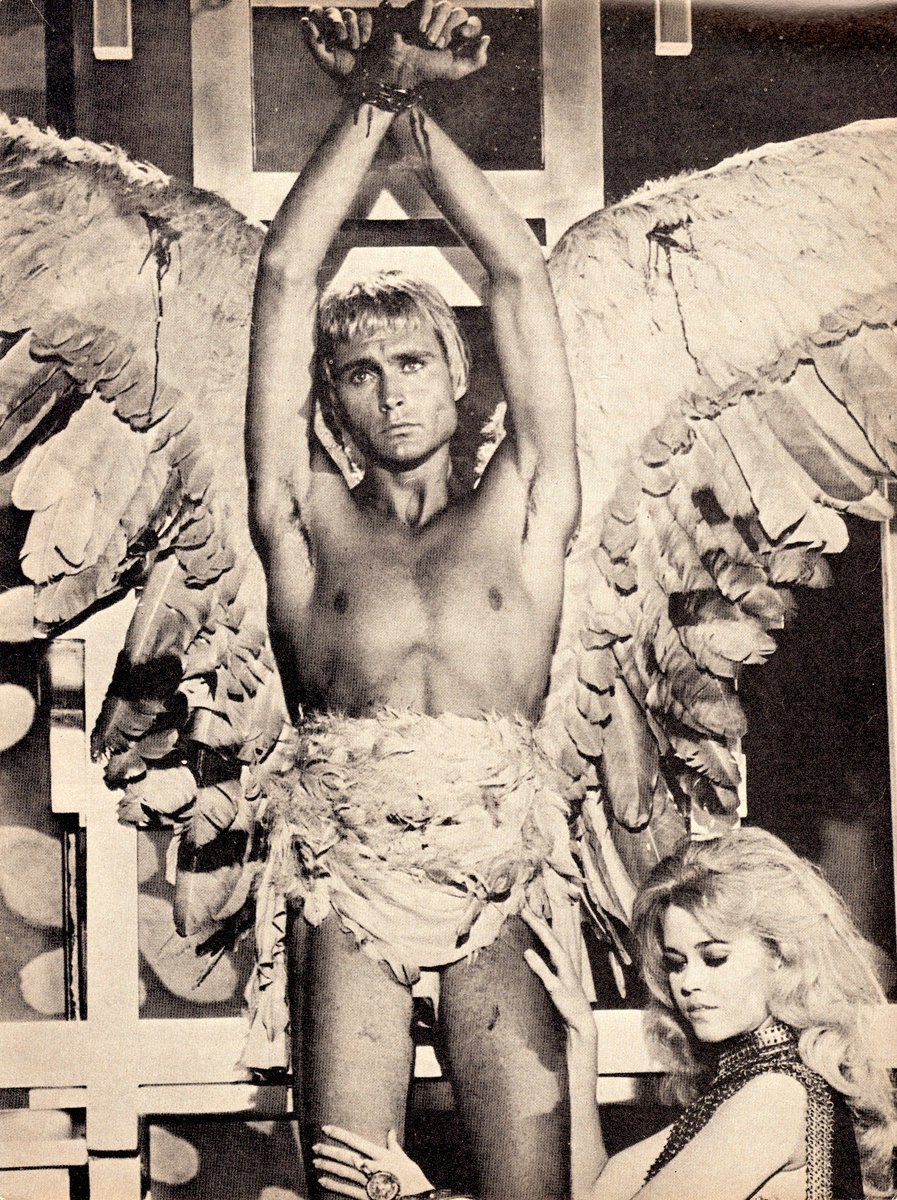
Storm ends up taking a fair amount of prominence during the Smith run, and it’s during the Smith run that she becomes fully the Claremont Ororo that we know today. The Morlocks are fascinating opponents in this story because they embody Storm’s greatest fears and vulnerabilities. Ororo is claustrophobic because she was buried alive as a child, and she fears confinement and feeling trapped. We also begin to see in these issues that Ororo also feels trapped by the woman she was in the past, and the expectations that others have of her in the present. The Morlocks, as led by Callisto, embody many of Ororo’s fears, as they come from the underground and dwell there. They also imprison others to satisfy their own desires, as they do with Angel and to a lesser degree with Kitty. But in an odd way, the Morlocks also embrace the kind of life that Ororo secretly yearns for—they are free to be themselves, living outside of society and existing on their own terms. Claremont doesn’t openly address these issues too heavily, but the undercurrent of Ororo’s arc runs deeply through the Morlock storyline.
During the trip down into the Morlock tunnels, the X-Men are attacked by the Morlocks. The Morlocks we see here include Sunder, Masque (a sadistic mutant who can reshape faces), and Plague (a mutant who can spread disease by touch). Plague attempts to use her power on Kitty, who phases though her hand, thinking to protect herself. However, intangibility doesn’t protect Kitty from her diseased touch, and Kitty gradually succumbs to illness over time.
While the X-Men win the first encounter with the Morlocks, a sick and weakened Kitty eventually gets separated from the group during the fight. She collapses in the tunnels, where she is recovered by Caliban, who we eventually discover is a member of the Morlocks. Caliban first appeared during the second Claremont/Cockrum run, and by this time, he has fallen in love with Kitty. Concerned for her, Caliban takes her back to the Morlocks, where he hopes to heal her and thereby win her love. It proves to be a story with a sad ending, though, as Kitty doesn’t love Caliban in the same way, especially since she loves Colossus by this point. Still, Caliban’s one-sided love for Kitty ends up playing a role during the early Morlock encounters up until the Mutant Massacre.
The remaining X-Men move further through the tunnels, eventually reaching Callisto. She is holding Angel prisoner, barely dressed and crucified. His pinfeathers removed and Angel is unconscious, treated as little more than an object by Callisto. Callisto openly declares that she desires Angel for her prince, which prompts Storm to think back on a past experience. As Storm reflects, “I was twelve when I saw a man gaze so at me—a prize to be won, an object to be possessed. My emotions, my wishes, meant nothing. Had I fought, my spirit would have been broken. I would have been used, then slain. So instead, I ran away from all that I loved, never to return.” Claremont never elaborates on this experience at any time, though Ororo’s thoughts imply that someone attempted to assault her. Ororo had grown up on the streets of Cairo as a thief, and it is likely that she’d seen threats of sexual violence often during that time in her life. It could possibly be that this horrific experience prompted her to leave Cairo, which led her on the path to becoming a nature goddess in Kenya once she grew older. We may never know, since Claremont never told that story, either here or during the remainder of his time on the X-Men books.
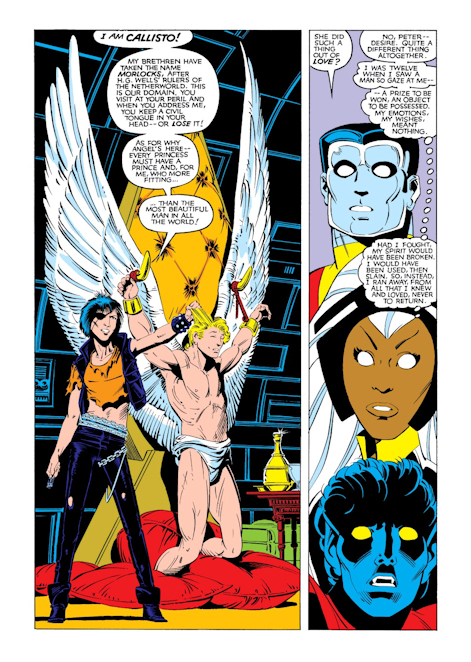
Nevertheless, it is a moment that hits upon Ororo’s fundamental themes as a character. Where Wolverine’s inner conflict is about the man against the animal within him, Ororo’s inner conflict is about overcoming her fear of confinement and embracing her true freedom and inner power. Storm sees herself in the Angel, who can fly but is bound to the earth and trapped beneath it. Moreover, he is a prisoner to the desire of another, a fate that Ororo has always fought to avoid for herself. As someone who values freedom—to fly, to choose love, to break the chains of the earth—Ororo finds Angel’s situation intolerable, and this perhaps fuels the cold fury that she unleashes against Callisto at the conclusion of this arc. From here, Callisto goes a step further and clips Angel’s pinfeathers, making him unable to fly and further imprisoning him. As someone who finds her own freedom in flight, Ororo is alarmed by this and immediately orders the X-Men into action. However, it is too late to stop Callisto, and the X-Men are overwhelmed by the sheer numbers of the Morlocks. The issue ends with Caliban vowing to defy Callisto and force Plague to heal Kitty before it’s too late to save her.
The next issue opens with a brief scene between Scott and Madelyne as their whirlwind courtship continues. Paul Smith makes these scenes look lovely and romantic, a scene of genuine love and affection. It’s the more important a scene, as it contrasts the real love between Scott and Madelyne to the false kinds of love that we see in the Morlock tunnels in this story. Where Callisto imprisons Angel and seeks him to love her by force, and Caliban imprisons Kitty through a love forced by obligation, what we see in Alaska is a genuine love growing on both sides. Through this contrast, Claremont makes the point that love must be given freely on both sides and not coerced in any way for it to be true and have meaning. However, even the joy we see in Scott and Madelyne is threatened by Scott’s doubts and whether Madelyne is really her own person. Deep down, though that isn’t Scott’s question—what he truly asks is whether he loves Madelyne or if he loves the shadow of Jean Grey that he sees in her. It is a fascinating question, and it hits the core of who Scott is, whether he can let go of a past obsession and the failures he blames himself for. This story goes a long way towards answering that question, and it would have been a satisfying answer if not for the undermining of the relationship by corporate decisions.
Throughout these past issues, Claremont also interludes small scenes that setup the Mastermind arc that ends the Paul Smith run. They’re generally designed to tease both Mastermind and Dark Phoenix, and one makes sense while the other raises questions. The first scene concerns Sebastian Shaw and his aide Tessa (secretly a spy for Xavier, who later becomes the X-Man known as Sage). Tessa discovers a comatose Emma Frost, who has been overcome by a powerful but unrevealed psychic force. This makes perfect sense for Mastermind, who previously had dealings with Emma, as she could be a threat to his own schemes. It’s designed to be a misdirection towards the return of Dark Phoenix, given that Jean had done something similar to Emma early in the Dark Phoenix Saga. However, it was intended only as a red herring, and in the end, Mastermind is the true assailant.
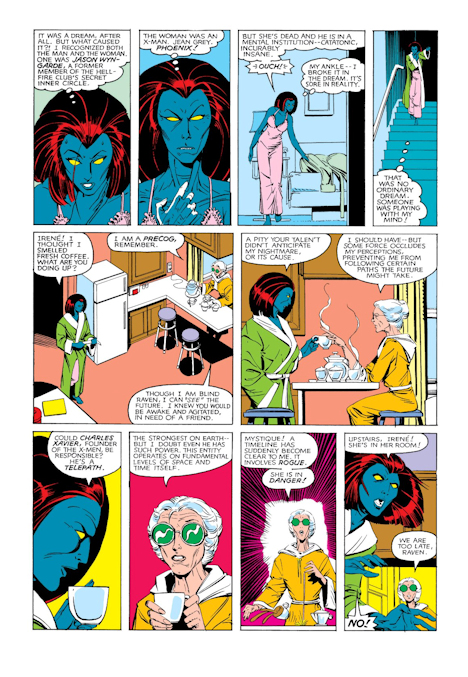
The second setup scene directly shows Mastermind and Jean Grey, who appear in one of Mystique’s nightmares. This one does not work so well as the Hellfire setup. Jason Wyngarde and Jean Grey appear in their 18th Century attire, reflecting Jean’s “time jumps” that were also illusions generated by Mastermind. It comes across as a reasonable attempt to foreshadow the manipulations of Mastermind in this arc… mostly. Claremont has Destiny’s precognition clouded by some unrevealed force that is implied to be Dark Phoenix. If Mastermind was acting alone, then how could he have done this? His powers are enabled by technology, but he’s not a telepath, let alone one powerful enough to obscure Destiny’s foresight. Moreover, there’s one nagging point that Claremont doesn’t explain—why would Mastermind target Mystique? As far as anyone knows at this point, the two have never met previously. Their only tenuous connection is through the Brotherhood of Evil Mutants—Wyngarde was a member of Magneto’s original team, but he never had any association with Mystique’s group. Mastermind tends to act either out of ambition or out of a personal grudge, and taunting Mystique doesn’t appear to serve either purpose for him. Did Wyngarde have ambitions of challenging Mystique for control of the Brotherhood of Evil Mutants, or was there some other motive? Unless Claremont himself answers that question, we may never know, as this was a dangling thread that was never addressed.
A more pressing concern that Claremont does address, however, is Destiny’s realization that Rogue has left home. We eventually learn why Rogue has left, because she’s wracked by a combination of guilt as well as her fear of losing control of her powers completely. Destiny does not foresee that Rogue has run away until it’s too late, also implied to be manipulated by an outside force that may or may not be Mastermind. Mastermind would have the motivation to help Rogue elude her foster parents, because Rogue’s presence causes division within the X-Men later. He would desire that because Mastermind wants to undermine and destroy the X-Men on a psychological level, and he is willing to use any tool he can manipulate to do so. The only problem, however, is how Wyngarde would have the ability to misdirect a powerful precog like Destiny. While this is not a major problem, it is a nagging issue that doesn’t quite work unless Claremont had a deeper explanation in mind or if a villain besides Mastermind was involved with this. Again, none of this is ever explained, and we will likely never know unless Claremont chooses to reveal this.
After a failed escape attempt by the X-Men, Kitty awakens in Caliban’s room, still sick from the disease inflicted on her by Plague. She urges Caliban to help her save the X-Men. Caliban wavers a little in his resolve—he wants to help Kitty, but he fears being abandoned by her if they succeed. Kitty is so desperate at this point that she gives her word to Caliban to stay with him forever if it means saving her friends. Caliban is satisfied by this, and he agrees. Caliban is a young man who is suffering from extreme loneliness, having been cast out from human society, and he is not even respected even by many of his fellow Morlocks. He’s holding on to Kitty in the desperate hope that she’ll love him, but it’s a love that can never be. Her heart is elsewhere, with Peter Rasputin, and the most she can give him is her friendship. Caliban is a sad and sympathetic figure in this story, and he’s ultimately used by Kitty as a means to an end. She doesn’t intend to do this, but as sick as she is and as desperate as she is, she’s willing to do anything to help the X-Men and especially Peter. The promise she makes to Caliban is a decision that comes to haunt her later during the John Romita Jr. era.
The conclusion comes when Caliban brings Kitty, driven unconscious by sickness, to Callisto in the hopes of healing her. Callisto refuses, not wanting anyone to leave the Morlock tunnels. As leader of the Morlocks, her word is law and cannot be challenged. The only way to save Kitty is for someone to challenge Callisto to a duel and defeat her in battle. At first, Nightcrawler offers to do this, but he hesitates when he learns that the battle is a duel to the death. Instead, Storm offers to challenge Callisto for leadership in single combat, a duel that will be fought with knives. The following battle is one of the most memorable fight scenes in the history of the X-Men, and one of Storm’s most defining moments as the X-Men’s leader.
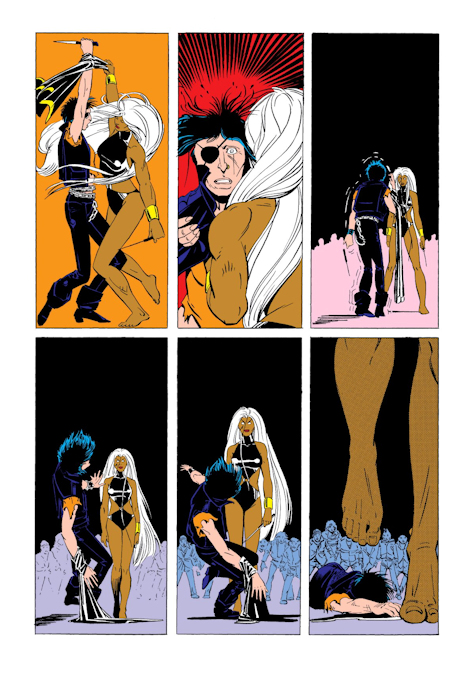
The battle between Callisto and Ororo is beautifully choreographed, very much a dance laid out in several pages. Although Claremont has a reputation for verbose writing, he also knows when to let the artist tell the story. The narrative captions only offer just enough to set the scene, while the layouts show exactly each step in the battle between the two women. The final page especially a tour-de-force of visual storytelling, as Paul Smith tells the story in complete narrative silence. Claremont offers not a single word as Storm stabs Callisto through the heart, and Callisto drops to the ground in defeat. Storm walks off without a word, her victory secured. Her silence says as much about her character more than any amount of dialogue ever could, and Claremont wisely allows Paul Smith to convey this. This is Storm at her darkest, having nearly killed an enemy to save her team, and she feels not the slightest amount of remorse for having renounced her promise to preserve life.
Storm declares herself the leader of the Morlocks. Her first act as Morlock leader is to declare that Kitty is free to go back to the mansion with Peter. She then makes a peace offering to the Morlocks, even allowing them to go with them to the mansion. Surprisingly, Caliban refuses the offer, even though it means not being with Kitty. He also never once brings up Kitty’s promise to him, probably out of concern for her well-being, realizing that this wasn’t the time to mention it. However, Caliban represents the hopes of the Morlocks, expressing a sincere desire to co-exist with the X-Men as friends. In the end, this ending establishes the future status quo with the Morlocks, which remains relatively stable until the Mutant Massacre.
Before Storm leaves, Nightcrawler calls Storm out on her behavior, asking her if she knew she had stabbed Callisto through the heart. Storm’s answer is simple and matter of fact: “I knew what I had to do when I made the challenge.” She had always planned to kill Callisto from the start, perhaps even since the moment Callisto mentioned that the battle was a duel to the death. Ororo had been slowly moving towards the darkness, a slide that began with her taking over leadership of the X-Men from Cyclops. Since then, Storm has made choices that have pushed her further against the side of life, first with her temptation to kill Magneto in his sleep and then later, when she killed the Brood embryo that had nearly killed her. This was a coldly deliberate act of attempted murder, one driven partly by Ororo’s hatred of what Callisto represents (a selfish, controlling woman who denies the freedom that Ororo values) and partly by her determination to save Kitty and rescue her team. At this point, we see how far Ororo is willing to go for the team, and it is much farther than we had ever seen from a team leader in the past.
At the same time, it is this very choice that makes Ororo the most fascinating and three-dimensional that the character had ever been. Under Claremont, Storm is a character who evolves from an untouchable, aloof weather goddess into a woman with an iron will, a powerful dark edge, and real flaws. Claremont brought a deeper sense of humanity into the goddess, and he did so largely by disconnecting her from nature and from the elements that defined the goddess. This moment, Storm’s willingness to kill Callisto to save her team, marks a major transition in her character from this point onwards. She is still someone devoted to saving life where she can, but this Ororo is much more ruthless and much more willing to make sacrifices to save those that matter to her. She has truly embraced her role as team leader, accepted a warrior aspect to her character, adding a new layer to one of Claremont’s most complex heroines.
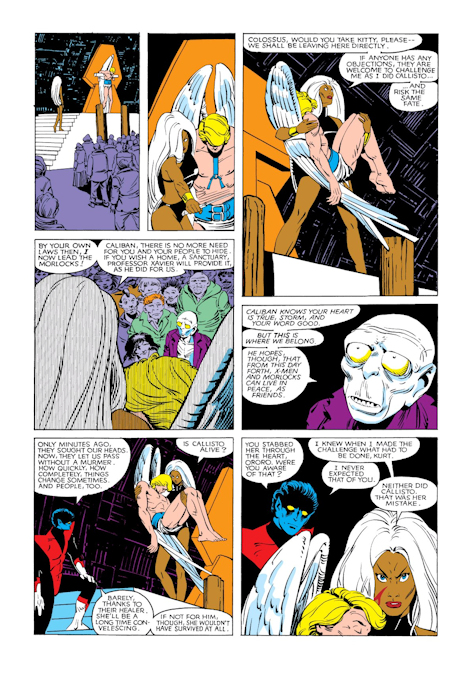
Finally, it should be noted that Paul Smith is indirectly one of the causes of the Mutant Massacre. At one point, Claremont noted that Smith had drawn “too many Morlocks” in this story. Claremont then put some thought into the question of what should be done with all the extra Morlocks. His decision, as he mentioned to Louise Simonson, was to kill them. This was the impetus that led to the Mutant Massacre, though this story wouldn’t finally happen until the end of John Romita Jr.’s tenure on the book.
The issue ends with another romantic talk between Scott and Madelyne, which ends with Scott revealing the truth about himself. Maddie innocently reaches for Scott’s sunglasses, causing Scott to lash out, fearing that his powers would accidentally hurt or kill her. Maddie confronts Scott about his strange behavior, unaware of Scott’s real reasons. At this point, Scott faces a choice—lie to Maddie and drive her away, or risk telling her everything. Scott chooses to come clean with Maddie, revealing to her that he is a mutant and how his optic blasts work. He flips a coin in the air and blasts it dead center. Maddie is understanding of Scott’s dilemma with his powers and she accepts him and his explanation, leading to their relationship growing even deeper. The scene marks a strong moment for the couple, and the visual storytelling is some of Paul Smith’s best as an artist.
Paul Smith is absent for the following issue, but his replacement is so legendary that it hardly matters. Walt Simonson filled in for the issue, a single-issue story that establishes how Rogue joins the X-Men. This turned out to be a beginning of a long association with the X-books, though he didn’t have a long association with Uncanny X-Men. Eventually, Simonson would team up with his wife Louise on X-Factor in later years, when the book focused on the original X-Men team. He would also be involved in later event stories—Walt Simonson’s defining Thor run would tie into the Mutant Massacre, and he also drew parts of Fall of the Mutants and Inferno. Claremont also played somewhat with Simonson’s characters at times, most notably during X-Men/Alpha Flight and The Asgardian Wars event. Simonson has written or drawn numerous titles in mainstream comics and elsewhere, most notably Thor, the Fantastic Four, and Orion, but he was a collaborator of Claremont’s from time to time.
The issue begins with Storm announcing her leadership of the Morlocks and once again antagonizing Callisto (who survived with the help of the Morlock Healer), presumably to put a rival in her place. Kurt again expresses concern for Ororo, especially as he notices the change in her, remarking that the Ororo he knew would have tried to make peace with Callisto rather than accept they would forever be enemies. This Ororo is a changed woman, more in touch with her darker nature, and she continues to change further for some time after this.
Back in Alaska, Madelyne awakens after a nightmare, and Scott rushes to her side to comfort her. At this point, their relationship has progressed further and become physical. Maddie explains her nightmare and opens up about her past (or at least the past she believes is true). Before working in Alaska, Madelyne claims that she was a commercial pilot who flew for large airliners, at least until a crash following a freak storm in San Francisco. The plane crashed, and Madelyne was the only survivor. Maddie’s reaction is consistent with post-traumatic stress, something that Scott has suffered from as well in his life. Oddly, though, the date of the crash was the same day that Jean Grey died, once more hinting at a larger revelation that was never part of Claremont’s plan. Maddie truly was intended to be a commercial pilot sucked into a chain of coincidences and the insanity of the X-Men’s lives. However, these details also led into the Inferno retcon of her past much later.
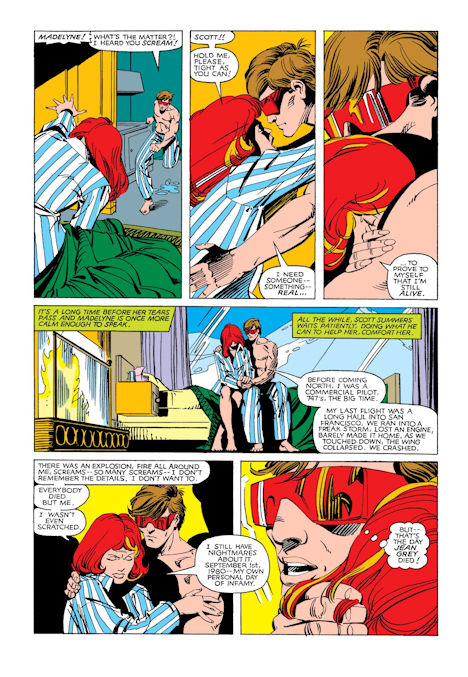
The main focus of the story is the arrival of Rogue at the X-Men’s door. Rogue has come to the X-Men because she has lost control of her power. She has an uncontrollable power, one that can absorb anyone’s power and personality into herself with the slightest touch. As mentioned in a previous Retrospective, Rogue ambushed Carol Danvers (the former Ms. Marvel and eventually, Captain Marvel) on the orders of her foster mother, Mystique. Rogue absorbed Carol’s power set as well as her personality, which now share the same body. Since the transfer, Rogue has been unable to handle the presence of Carol in her mind, mixed with guilt over stealing her mind in the first place. With no other options, Rogue left home to get help from Professor Xavier in the hopes that he might help her.
Nowadays, so many villains have been accepted into the X-Men that no one thinks twice about it now. Many villains who have done much worse things have been accepted into their ranks, from Emma Frost and Magneto to murderous and even genocidal villains like Sabretooth and Apocalypse. At the time Rogue joined the team, it was rare for villains to join the team, which had not been done since the Silver Age. There had been mutant villains who had joined teams like the Avengers, including Quicksilver and the Scarlet Witch, but they hadn’t committed any major crimes. Rogue, however, had done a truly terrible thing that had deeply violated someone that the team considered a friend. Unlike the modern age of X-books, Claremont was determined that Rogue earn her place on the team, and that the consequences of her past actions were openly addressed as they should be. When Rogue asks for the team’s help, she is initially met with heavy distrust and even outright hatred from people like Kitty. The reaction from the team is so negative that Xavier orders the rest of the team out of the room while he attends to Rogue. This is a stark contrast from the way these characters are admitted nowadays, where serious crimes are pushed under the rug so that villains can remain on the team.
The X-Men attempt to take out their frustrations in various ways, with most of them opting for a Danger Room session, which goes wrong because of unintentional tampering by Illyana. From there, Storm goes to her loft and becomes agitated as she realizes that her powers are not responding to her as they once did. Because Ororo’s powers are tied to her emotional state, her darker side is warping her desires. When Ororo attempts to water her plants with a simple rain, it becomes a downpour that drenches them instead. Torn apart inside, Ororo is agitated, to the point that a simple psychic contact triggers her enough to throw a knife at the psychic projection. She vents her anger towards the wall: “It is because of you that I became an X-Man, old man, and that decision is destroying me!” Xavier senses the distress, but he does nothing, because his current problem is Rogue.
On some level, Ororo recognizes that she is changing into something different, and she doesn’t entirely like the woman she is becoming. She is still wrestling with her two states—the woman she was, and the woman she has become. In a sense, Storm is correct when she says that the decision is destroying her. However, it isn’t the fact that she became an X-Man that is changing her, but her acceptance of leadership of the team. Ororo has changed because of the demands of leadership, because she sometimes has to make difficult choices that determine the life or death of those around her. She has at times had to make those decisions as an X-Men, such as when she killed the Brood embryo. But nearly killing Callisto was a sacrifice that Ororo made for what she felt was for the good of the team. Being that person has cost her emotionally, and her decision to break her oath to life that she once held sacred still weighs on her at this time. But it’s also a decision that makes her human, and the most fascinating character during this period of the book.
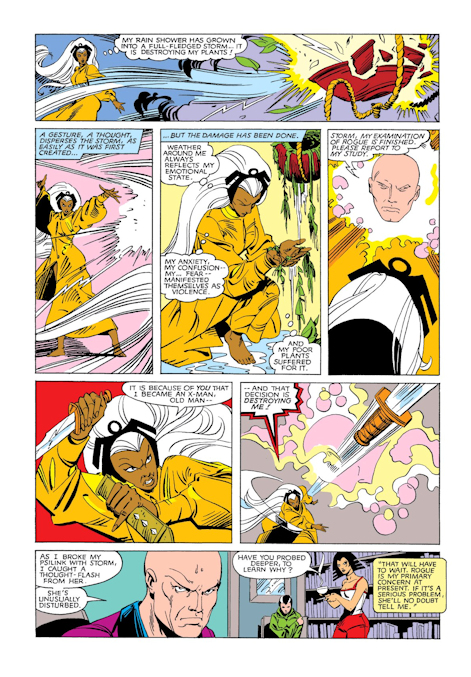
The final spark of conflict comes from Carol Danvers in her Binary form, who arrives at the worst time. Storm and Xavier argue because Xavier has admitted her to the X-Men without consulting Ororo. Storm, as team leader, opposes the idea of admitting Rogue, concerned that Rogue cannot be trusted. Shortly after, the scene cuts to Binary walking into the mansion, and then Rogue flying violently towards orbit after a single punch from Binary. A battle between Rogue and Binary rages after this, until Xavier declares that Rogue is under his protection and ends the fight. Carol takes the news badly for understandable reasons—in her eyes, her friends are siding with the woman who destroyed her life. However, Xavier will not abandon someone who needs his help, a resolve that shows his more charitable side under Claremont. Rogue is accepted into the team by the end of the issue, but Carol decides to leave Earth with the Starjammers, feeling there is no place for her left on Earth. She would stand by that decision for many years, at least until her later stint with the Avengers under Kurt Busiek.
Wolverine returns to the team in the following issue, along with Paul Smith. Logan was not involved with the last three issues, since he was in Japan during that time. In the last part of this Retrospective, we discussed the Wolverine limited series, which is my favorite Logan story of all time. In that story, Logan had killed Lord Shingen, the criminal father of the woman who would become his fiancée, Mariko Yashida. The mini-series concluded with Logan becoming the champion of Clan Yashida, and with the X-Men receiving a wedding invitation from Logan. Back in Uncanny X-Men, the team flies to Japan to attend the wedding of Logan and Mariko. However, because Wolverine’s life is marred by tragedy and death, their relationship is sadly never destined to last.
Although Shingen is dead, Mariko still has many enemies because of the criminal connections that her father had established during his reign as lord of the clan. Chief among these are Silver Samurai and his partner and lover, Viper, villains that Claremont established in his canon with his run on Marvel Team-Up. Samurai began as a Daredevil villain, but he’s today more strongly associated with Claremont because of a Marvel Team-Up story that featured the Saturday Night Live cast. Since then, he faced the New Mutants as well as the X-Men. However, Silver Samurai’s primary enemy is now Wolverine, largely because of this story. The Silver Samurai is one of Logan’s better recurring enemies, especially because he has a personal stake in this story; he is Mariko’s half-brother, Keniuchio Harada, and he wants to rule the Yashida Clan himself.
Viper has a complicated history, having began her career as Madame Hydra and then taking the Viper name from a minor supervillain. However, Viper was not always written consistently, depending on who was writing her and in what title she appeared in. She is typically a Captain America villain, though Viper also joined the Wolverine rogues’ gallery because of this story. Under writers like Steve Englehart, J.M. DeMatteis, and Mark Gruenwald, Viper is a much more nihilistic, ruthless, and evil villain, with schemes usually devoted to causing chaos and mass death. Claremont typically wrote her somewhat differently, occasionally more sympathetically, though still dangerous and ruthless in a general sense.
Although Samurai and Viper are the main villains of this arc, Mastermind is pulling the strings behind the scenes. Ruining Wolverine’s wedding moves along his schemes of revenge against the X-Men. His motivations are sadistic by this point, taking pleasure in causing the pain of his enemies for the sheer joy of taunting them. Mastermind doesn’t show his hand openly until the final confrontation in the following issues, but his presence is keenly felt during the Japan arc.
Primarily, this arc is a Wolverine story, though the primary focus lies on his relationship with Rogue. By the time she joins the team, Wolverine has no reason to like or trust Rogue. Logan had been a friend of Carol Danvers for many years, mainly through shared adventures during the time when he worked for Canadian intelligence. In Logan’s eyes, Rogue is someone who destroyed a friend’s life, and that is a difficult thing for him to forgive. This arc is about how Rogue proves herself to the team, but especially to Logan, who is Rogue’s harshest critic at this point in the team’s history. At the same time, it’s also a story about Logan being able to find forgiveness in his heart for a former enemy. Claremont also may have thought the best way to establish Rogue as a trusted ally is to have her win over the most critical member of the team, which is Logan.
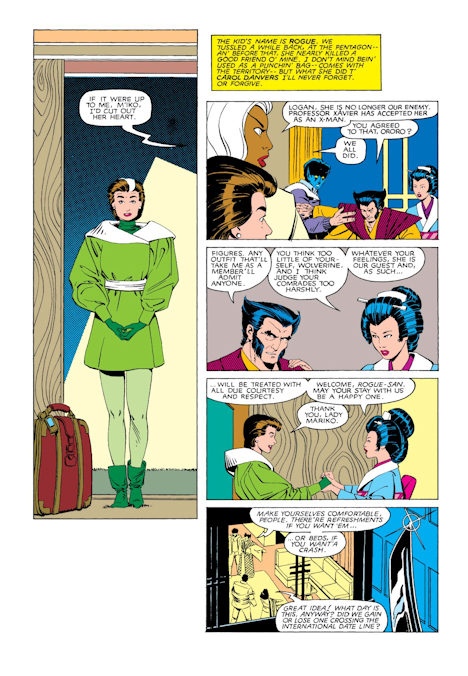
One point that encourages this arc is the fact that Mariko is the only person who welcomes Rogue into her house. Wolverine still has hard, bitter feelings over what Rogue did to Carol, and the other X-Men still don’t fully trust her. Mariko, however, has no preconceptions about her, and she is moreover guided by rules of hospitality as a Japanese noblewoman. The kindness that Mariko shows her ends up leading to Rogue’s redemption later.
The Silver Samurai observes the Yashida house, only for Yukio to intervene for her own reasons. Yukio is a former lover of Wolverine, a ninja who was left masterless after Shingen’s death. The Samurai is driven off with the help of Logan, Kurt, and Ororo. However, the meeting leads to Storm building an odd friendship with Yukio (which is often hinted to have deeper overtones). Ororo takes a liking to Yukio because she feels free to be who she is without compromise, and wishes should be the same way. In the meantime, Mariko leaves to handle clan business she is keeping from Logan, while Wolverine catches up with the X-Men. Viper uses the opportunity to impersonate a Yashida family servant and poison the X-Men’s tea, leaving most of the team unconscious. Only Wolverine and Storm manage to avoid the danger, Logan because of his healing factor and Storm because she was warned before she drank the tea.
In the meantime, Yukio attempts to impersonate Mariko as part of her own plan against Viper and Samurai. Mastermind assumes the identity of a man named Yokuse, who sees through Yukio’s deception and exposes her. During the battle, Storm arrives and tries to throw lightning at the villains, but she loses control of her lightning to dangerous effect. The outcome of the battle goes poorly for both sides, with Viper getting hurt in the battle and Yukio and Storm slipping away but in weak shape. The issue ends with Logan reluctantly agreeing to work with Rogue to find and defeat the Silver Samurai.
For the most part, the plot structure of the next issue is simple. Rogue and Wolverine work together to find and stop the Silver Samurai, while Storm and Yukio try to survive on the streets of Tokyo. However, the execution is very elegant as drawn by Paul Smith, and the characters all get good moments together. Yukio and Storm are among the most interesting, as the two get mobbed by a gang of six, and Storm’s powers still aren’t working properly. Along the way, Ororo continues to embrace her darker nature, giving in to what she considers Yukio’s “madness”. She comes to enjoy the fight, even to the point of inflicting pain with her powers, something Ororo once swore she would never do. Yukio is a dangerous influence on Storm, but the two are fun to watch together, and it’s easy to understand what Storm sees in her.
Rogue and Wolverine confront the Samurai and Viper, but only after realizing that they’ve been set up with a wild goose chase across Japan. While the X-Men were chasing the Samurai, he has been after his real goal—to reach the hospital and kill Mariko. Rogue defeats Harada’s ninjas while Logan fights the Samurai in single combat. Like the battle between Storm and Callisto, Claremont gets out of the way and lets the visual storytelling work its magic. Over two pages of this battle are completely silent, as the art carries the emotional weight of the battle. It also works quite well in a narrative sense, as samurai battles like this are more compelling when focused on action rather than words. This is one of the truly great battles of the Smith run, along with the Callisto battle, and the storytelling is absolutely superb in every single frame. The coloring by Glynis Oliver (credited in this issue as Glynis Wein) also is perfect, as the red background coloring adds the right amount of visual contrast with the fighters.
With the battle resolved, Viper turns to kill Mariko. Logan moves to save Mariko, but he isn’t fast enough to evade Viper’s blaster gun. Rogue, remembering the kindness done to her by Mariko, decides to take the brunt of the blast to save Mariko and Logan. The gun explodes in Viper’s hand, and Viper is forced to flee with Harada. Mariko and the X-Men are safe, but Rogue lies near death after having taken too much damage from the blaster.
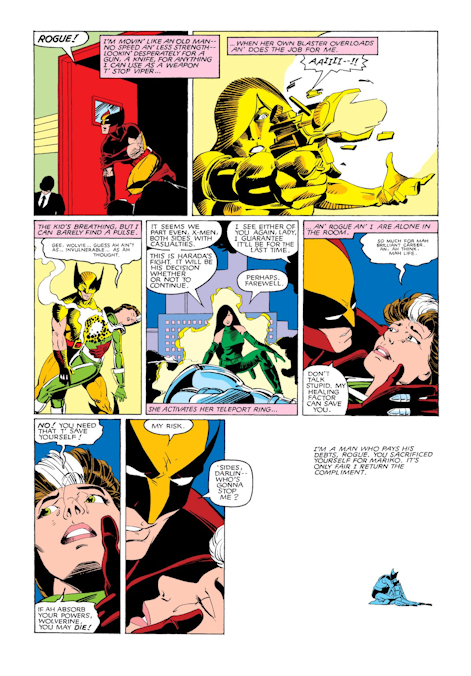
Logan, however, is too honorable to allow Rogue to die that way, especially after Rogue had sacrificed herself to save Mariko. Logan makes a decision that is echoed later in the first X-Men film, and he allows Rogue to take his power to heal herself. Rogue eventually recovers, and her sacrifice earned the trust and respect of Logan. Ever since then, Logan and Rogue are reliable friends to each other, and the past is largely forgotten.
Although the X-Men won the encounter, the final victory belongs to Mastermind. Wyngarde approaches Mariko in the guise of “a friend” and mentally programs Mariko to do his bidding. However, the wedding continues as scheduled as far as anyone knows. The X-Men are all in attendance for Logan’s wedding to Mariko, as are Professor Xavier and Empress Lilandra. The Summers family arrive as well, including Lorna Dane (otherwise known as Polaris) as well as Madelyne Pryor.
The X-Men generally react to Madelyne with shock because of her resemblance to Jean Grey. Lilandra initially threatens to kill Madelyne, thinking that she’s Jean. Even Storm is taken aback when presented with a woman who is the spitting image of her dead best friend. In time, the X-Men do come to accept Maddie as part of their “found family”, and her resemblance to Jean quickly ceases to become any sort of issue.
The one who accepts Maddie the easiest is Kitty, who only knew Jean briefly and didn’t spend very long with her. She and Maddie get along quite well at first, especially given their shared interest in aviation. However, there is a funny moment before the wedding when Kitty leaves a sleeping Lockheed with Maddie, who doesn’t realize that Lockheed is a dragon and assumes that he’s a cat. Her reaction is to do a double take, then turn to Scott and say: “Just precisely who are these people, and what the blazes have you gotten me into?” It’s a perfect human moment from Maddie, and this is where Madelyne is the strongest as a character. She is a refreshingly normal character with ordinary human reactions to the crazy world of the X-Men, and she reacts the same way that a regular person would.
At the end, though, Mastermind’s poison has done its work. Mariko addresses the guests and announces that there will not be a wedding. Her reasons for calling off the wedding echo the words of Lord Shingen: “because, gaijin—you are not worthy.” The issue ends as Mastermind looks on while Mariko walks away. The final panel is a perfect Paul Smith panel, showing Wolverine with a single tear running down his face, heartbroken.
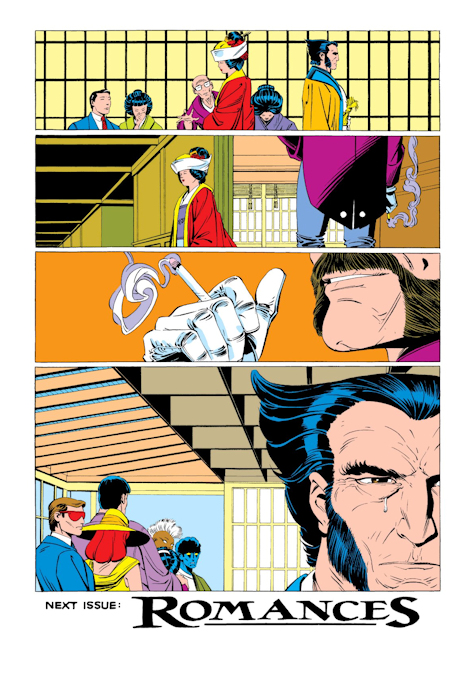
These issues are some of the best issues of Uncanny X-Men, certainly in the post-Byrne era. Paul Smith was an outstanding addition to the series, and his visual storytelling brought Claremont’s stories to almost unparalleled heights. This period also includes two of the best single fight scenes during the Claremont era, and to find another artist even comparable at drawing battles, you generally have to look to Frank Miller or John Byrne. To this day, Smith remains an excellent artist, and he left an excellent body of work on this book. His run is relatively short, coming to an end soon after these stories, but they are among the finest visual achievements on this title.
Love is the recurring theme of the Claremont/Smith era as well, and this is a time when the romantic subplots were among the most powerful. The Scott/Madelyne relationship and courtship is a strong B-plot that runs throughout these issues. Claremont and Smith do an excellent job of selling their romance in a relatively short time, and Madelyne comes across as an interesting character in a few short issues. The other prominent romance is Logan/Mariko, and although their ending is a tragic one, this is still my favorite relationship involving Logan. When the heartbreak comes, it cuts deeply, and that is a testament to Claremont’s writing and how much he made that relationship work. The triangle between Peter, Kitty, and Caliban also works quite well in these issues, and Caliban is a sympathetic unrequited love interest for all that he is a sad character at his core. Even the villains represent love in some way, even if love for them is often twisted; Callisto and Silver Samurai/Viper are the most notable examples of this idea. The basic theme holds up the stories in this period, and ultimately makes them read better when read as a whole arc.
Another major accomplishment of the Paul Smith era is the development of Storm. Smith gravitated to Storm as a character, and Claremont accommodated this, as was his way. This era marked the beginning of the Mohawk Storm, which debuted during the aborted wedding issue. However, it was the characterization of the darker, wilder Ororo that was truly innovative and opened new doors for the character. While I’m generally skeptical of darker, edgier takes on classic characters, Chris Claremont understood Ororo in a way that no other writer ever has, and he was able to make it work. It was also built up gradually over time, and when the change finally happens, it’s explored logically and with character consequences. This period of Storm is easily the greatest in the history of the character, and her character development feels natural and logical despite the shocking changes.
The conclusion of the Mastermind arc will wait until another time. When we resume, we’ll discuss my favorite Cyclops story of all time, as well as an X-Men wedding and the end of another era. We’ll also discuss the arrival of John Romita Jr., another artist with a notable impact on the X-Men. Storm evolves even further, and we’ll explore the impact this has on the X-Men. See you then!
Author Profile
- Steve Sellers had been a fan of superheroes ever since Superman: The Movie. But it took the JSA, the Legion of Super-Heroes, Dragonlance, Lord of the Rings, Twilight Zone, and Chris Claremont's legendary run on the X-Men to make him a writer and a longtime fan of comics, fantasy, and science fiction. Steve is the co-creator of WHITE DRUID & MICHAEL NERO and GUARDIANS OF ELAYIM for Omen Comics, and he is also the creator of BLITZ and SHOCKWAVE for Revelation Comics (an imprint of Omen Comics).

